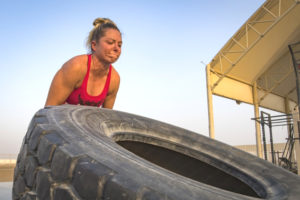In this medical notice to all US servicemen and women, the US Military Health system takes a look at Osteoporosis and provides advice that is very relevant to all of us (that is to say, both men and women), as we get older.

Bones are living, growing tissues that begin to feel the wear and tear of ageing years before symptoms show. Osteoporosis, a severe form of bone density loss, affects roughly 10 million people in the United States. But once the disease becomes evident, usually as a broken bone, it’s too late to reverse the damage.
“Osteoporosis is a silent disease that doesn’t give patients any symptoms until something happens,” said Army Maj. Kate Kinnaird, an endocrinologist at Fort Belvoir Community Hospital in Northern Virginia. The National Institute on Aging defines osteoporosis as a disease that weakens bones to the point where they break easily, most often affecting the hip, backbone, and wrist.
Related Article: New Physical fitness standards for combat roles
As people grow, the body breaks down old bone and replaces it with new bone tissue until it reaches peak bone mass sometime between the mid-20s and early 30s, said Kinnaird. Bone continues to break down as a person ages, but the replacement process slows.
Bone density loss is a natural part of ageing that impacts both men and women, but women are more likely to develop osteoporosis, said Kinnaird. According to the Department of Health and Human Services, more than 80 per cent of Americans with osteoporosis are women.
Hormones also play a role in building and strengthening bones, placing post-menopausal women at risk for osteoporosis due to the loss of estrogen. Bone loss occurs the fastest in the first few years after menopause, with one in four women age 65 and older being affected in the U.S, NIA said.
In addition to gender and age, other risk factors for osteoporosis include low body weight, a small frame, family history of the disease, and lack of physical activity, Kinnaird said. Smoking, daily alcohol intake, eating disorders, certain medications, and certain diseases, such as hyperthyroidism and diabetes, can also increase risk.
“There are certain patients that we know based on their medical history, or the medications they’re on, that would be at higher risk of early bone loss, so we’ll screen them sooner than we would the general population,” said Kinnaird.
The U.S. Preventive Service Task Force recommends women aged 65 and older, as well as women younger than 65 who are at greater risk, get screened for osteoporosis. For post-menopausal women, bone density is tested through an exam that compares a patient’s bone density to the density found in an average healthy adult of the same gender. The test result, known as a T-score, indicates how strong bones are, whether osteoporosis or low bone mass exist, and if the individual is at risk for having a fracture, said Kinnaird. For women who haven’t gone through menopause but have at least two risk factors, bone density is compared to patients in their own age group, she said.
Related Article: Invictus Games 2018 Team UK Announced
Air Force Maj. Christopher Wild, a staff orthopaedic surgeon at Wright Patterson Air Force Base in Ohio, said being able to identify and treat people who have signs of bone loss can help prevent fractures. Once a person is diagnosed with osteoporosis, treatments focus on preventing further bone loss. Such treatments, which usually focus on proper nutrition and exercise, are based on the cause of the disease. The choice of medication is dependent on the severity of the bone loss and the patient’s risk for fracture, he added. Medications can include bisphosphonates, estrogen therapy, hormone therapy, parathyroid hormone, or calcitonin,
“The best treatment for osteoporosis is prevention,” said Wild. He recommends eating healthy, staying active, and having vitamin D and calcium daily to help maintain strong bones.
“Young people in their late teens and 20s can still influence their peak bone density, so it’s important to make sure to be active and eat healthy while young and growing,” he said. A diet with nutrient-rich foods, such as dairy, fish, fruits, and vegetables can improve a person’s overall health and the health of the bones. The recommended daily intake for an adult is 1,200-1,500 milligrams of calcium and 800-1,000 IUs of vitamin D per day, he said, while children ages 9-18 should get 1,300 milligrams of calcium.
While low-impact workouts, such as swimming, can be good exercise, Kinnaird recommends using weight-bearing exercises, strength training, or resistance training for bone health. Exercises like walking and running can add enough stress to bones to maintain their strength, she said.
“Osteoporosis may be more common among older women, but it’s important to take care of ourselves as early on as possible, “said Kinnaird. “The choices we make every day about food and exercise can make a significant difference later on in life. It’s not too late to start.”
Words and images copyright of the US DoD, Health.mil, the official website of the US Military Health System.

Comments on Sticks and stones can break bones – and so can osteoporosis